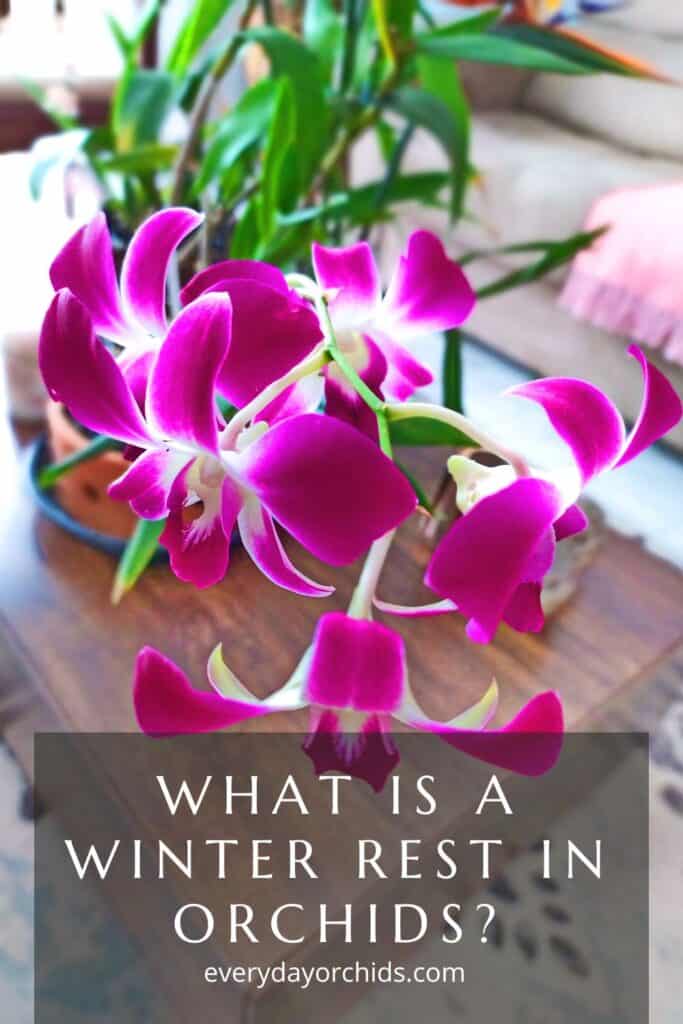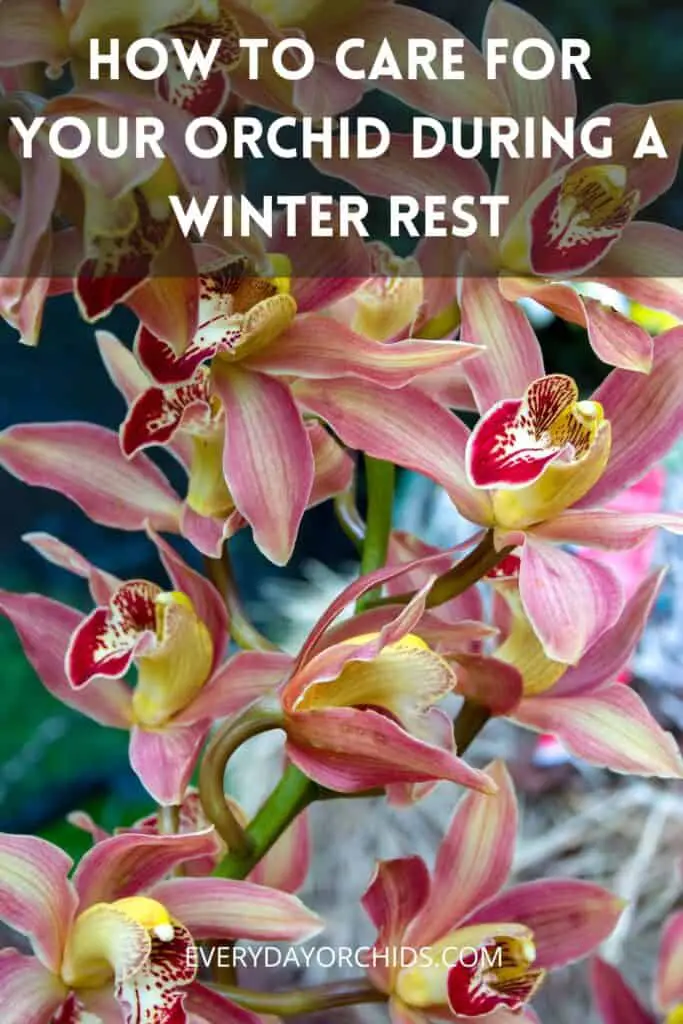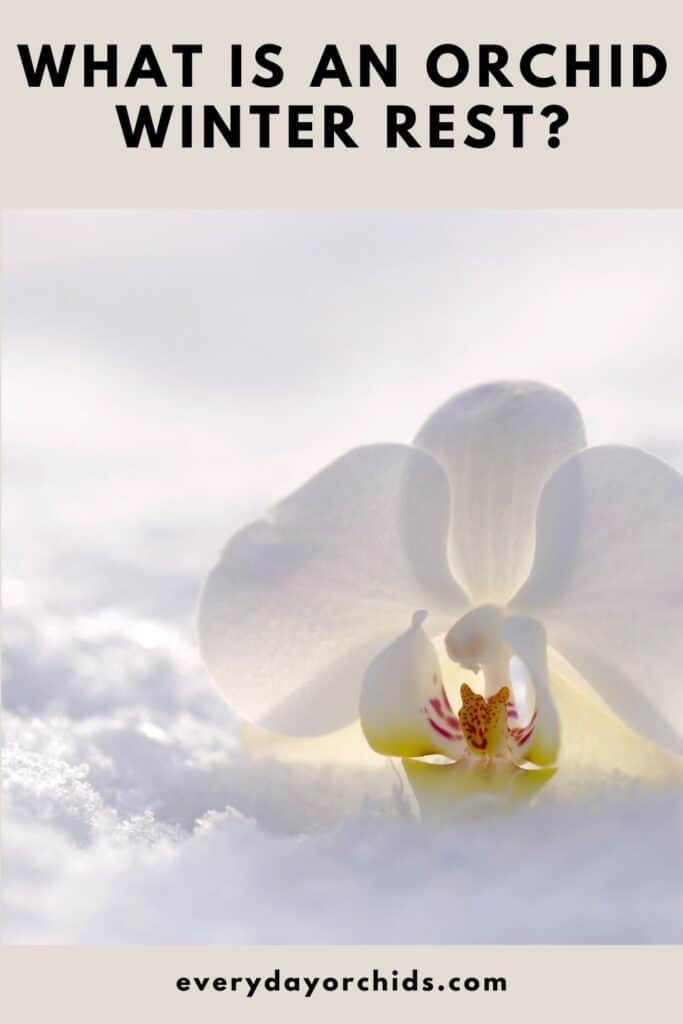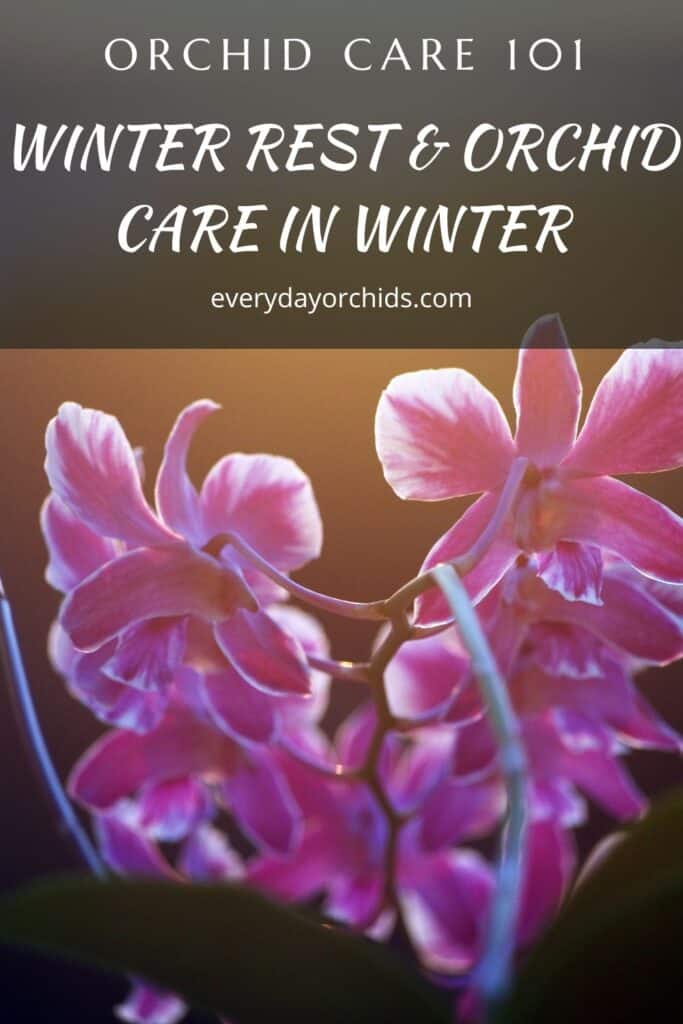If you are new to orchid growing, the term “winter rest” may seem foreign to you. After all, the care requirements for many other houseplants stay the same throughout the year. Some orchids, on the other hand, have a different set of growing requirements and care needs in the cooler fall and winter months. This is what is called a “winter rest.”
A winter rest is basically when an orchid becomes dormant. This period of rest coincides with a drop in temperatures. It requires a gradual slow down and eventual cessation of watering and fertilization during the cooler winter months.
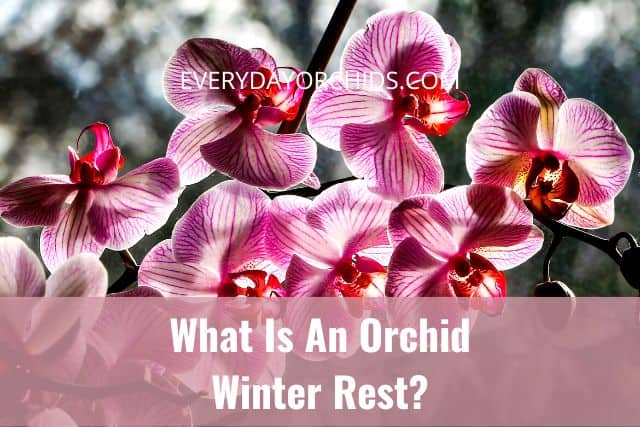
However, not every orchid undergoes a winter rest. In this article, you’ll learn more about what a winter rest is and why certain orchids need it. You’ll also learn how to support your orchid and continue to care for it during the winter rest period. Lastly, I’ll go over what might happen if your orchid doesn’t get a winter rest. Keep reading to learn more.
Please note that these links are affiliate links and as an Amazon Associate, I earn from qualifying purchases. Purchases made through affiliate links in this post may generate commissions at no additional cost to you. Use this link for a discounted Amazon Prime trial. Thank you for your support!
Table of Contents
What Is A Winter Rest?
So, what is a winter rest? In terms of orchid care, a winter rest is essentially a reduction or total cessation of watering and fertilizing during the cooler months of the year.
It is not a sudden cessation however. You’ll gradually ease your orchids into it during the early fall months.
When fertilizing your orchids in the late summer and early fall, use a bloom booster orchid fertilizer. Bloom booster fertilizers typically have a higher level of phosphorus, which helps support bloom production.
Continue to fertilize your orchid with a diluted bloom booster orchid fertilizer every other week in the early fall. This is a slow-down in fertilization from the growth period during the summer, when you were fertilizing “weekly, weakly.”
You’ll generally want to stop fertilizing your orchid in late September or early October, during the early fall months.
Likewise, for watering, you will gradually decrease your watering efforts in early fall. Gradually decrease watering frequency during September and October.
If your orchid needs a winter rest, then fully stop watering this orchid around November, when temperatures start to really drop.
This winter rest correlates with an orchid’s naturally occurring dormancy period.
In the northern hemisphere, here in the United States, a winter rest would generally start in November and last through February. However, this time frame for a winter rest is not set in stone. In fact, it may vary depending on the orchid species in question.
If you are in Australia in the southern hemisphere, a winter rest would start around your late fall and winter period, which generally starts mid-May and lasts through August.
Why Do Orchids Need A Winter Rest?
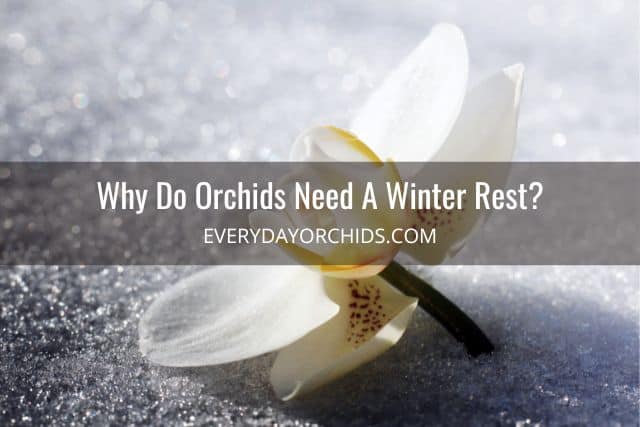
If you are new to growing orchids, the idea of a winter rest may seem foreign to you. After all, most other houseplants do not need a winter rest. However, many orchid varieties, whether they are indoor orchids or outdoor orchids, will need a winter rest.
A winter rest in certain orchid species gives the orchid a break from watering and fertilizing during their dormant period. It is necessary in order for the orchid to bloom in the spring.
During a winter rest, your orchid will not die if you stop watering or fertilizing it for a few months. It will simply use the water and nutrients stored in the pseudobulbs or canes during this time.
Which Orchids Need A Winter Rest?
This is a big topic and I go into this in more depth in another article. I will just say briefly here that many species of orchids, such as the Dendrobium Nobile orchid, and deciduous orchids (more on that below) undergo a winter rest. Phalaenopsis orchids, one of the most popular orchids out there, do not need a winter rest.
Get to know your specific orchid’s growing requirements and care needs in order to determine if your orchid needs a winter rest or not. You can also check out my article on which orchids need a winter rest for more information about specific orchid species.
When Do Orchids Go Dormant?
An orchid’s dormant period generally begins when temperatures start to drop in the late fall and early winter.
If your orchid happens to be a deciduous orchid, it will also shed its leaves as the winter rest period begins. The shedding of leaves on your orchid is a lot like how many trees lose their leaves in the fall.
When an orchid starts to lose its leaves, it will also lock in moisture in the canes or pseudobulbs and stop growth. Leaves falling in a deciduous orchid are a signal that the orchid is entering a period of dormancy and the winter rest has begun.
What Happens If You Forget To Give Your Orchid A Winter Rest?
If your orchid happens to be a species that needs a winter rest and you don’t give it one, it may struggle to produce blooms in the spring. In other words, your orchid may fail to bloom.
The drop in temperatures, along with a decrease in watering and fertilization, initiates bloom production in these orchids. If you continue to water and fertilize your orchid through the winter months, it won’t receive the signals it needs to start flower production.
This is why it’s so important to know your orchid’s particular growing needs and whether or not your orchid variety needs a winter rest or not.
What Happens If You Water Your Orchid During A Winter Rest?
Let’s say you have an orchid that needed a winter rest but you were not aware and continued to water and fertilize it throughout the winter. What’s the worst that can happen?
Well, as I mentioned above, your orchid may fail to produce flowers come spring. In addition, your orchid may develop root rot, pseudobulb rot, or rotted canes. This is because of constant exposure to damp potting media and continuously providing the orchid with water it doesn’t actually need.
As a result, your orchid may start to struggle. You may see limp, wrinkled leaves in your orchid, or it may be more vulnerable to pests and disease.
Keiki production may also occur, which isn’t necessarily a good thing. Keiki growth can be a sign that your orchid is dying and making a last ditch effort to pass along it’s genetic material.
How Do You Support Your Orchid During A Winter Rest?
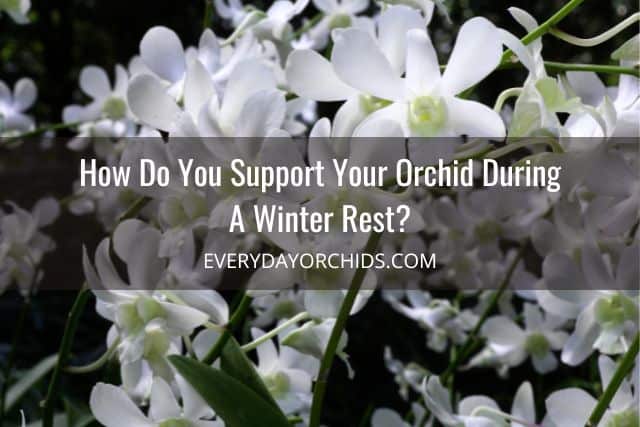
Most winter rest periods last 3 to 4 months. In many cases, during an orchid’s winter rest, you will not water or fertilize your orchid until growth begins again in the spring.
However, this doesn’t mean that you stop caring for your orchid during the winter.
There are a few key things you will still need to do during the winter rest period. For example, you’ll still need to maintain humidity and lighting in your orchid’s growing area. This will ensure that your orchid’s chances for success are maximized. I’ll talk about each of these key care components in more detail next.
Orchid Winter Rest Care: Temperature
First, let’s talk about temperature requirements during an orchid’s winter rest.
Make sure that you expose your orchid to cooler nighttime temperatures and warmer daytime temperatures during the fall and winter.
Aim for a 20-degree Fahrenheit temperature difference between night and day.
Along with the cessation of watering and fertilization, this drop in temperature will help initiate bloom production in your orchid.
To learn more, you can read about how to bloom and rebloom orchids here.
Orchid Winter Rest Care: Lighting
Many orchids require at least 12-14 hours of bright, indirect sunlight each day. Orchids use this light to perform photosynthesis and harvest energy.
Adequate lighting is essential in order for an orchid to produce blooms each year.
The amount of light an orchid gets during the winter months, or lack thereof, may be the deciding factor in whether your orchid blooms comes spring.
Fall and winter months have shorter days and lower levels of light. If you find that your orchid’s growing area isn’t receiving enough light, you may want to move your orchid to a different location.
Find an area in your house where your orchid may be exposed to more light. For example, if you usually keep your orchid near an east-facing window, you may want to consider moving it to a south-facing window.
Also keep in mind that the quality and amount of light coming through the window may vary, depending on if the trees in front of the window have dropped their leaves.
An alternative is to set up artificial lighting for your orchid. I’ve gone over how to do this in detail in this Everyday Orchids article about artificial lighting and orchids. In that article, I walk you through the different lighting options available and which one might be best for your orchid, so be sure to check it out.
Many orchid growers use artificial lighting, particularly when the days get shorter. It is a great option if your house doesn’t have great natural lighting. Making sure your orchid has enough exposure to light is essential to getting it to produce blooms.
Orchid Winter Rest Care: Humidity
Even if you aren’t watering your orchid during its winter rest, it is still important to maintain adequate humidity levels.
The amount of humidity your orchid needs will depend on which type of orchid you have. You can easily measure your home’s or orchid growing area’s humidity levels using an inexpensive hygrometer.
Humidity levels often drop during the cooler winter months. Keep an eye on your orchid growing area’s humidity levels. Naturally drier air, combined with central heating in homes, can lead to a significant drop in humidity levels. In some homes, humidity levels can fall as low as 30% or less.
Low humidity levels often result in dried, shriveled aerial roots for your orchid and slower growth, among other things. Think of how your skin becomes drier in the winter. Your orchids will experience the same effects of low humidity levels. You can read more about the importance of humidity and orchid growth here.
If you find that humidity levels are low in your orchid’s growing area, you will likely need to supplement humidity levels using a humidifier, humidity tray, or some other means.
I have this cool-mist humidifier near my orchids and keep it running during the daytime most days during the fall and winter. The difference in my orchids’ health is huge. I’ve noticed better root and leaf growth and healthier looking orchids overall.
Orchid Winter Rest Care: Pruning And Pest Control
You will also want to regularly inspect your orchids for pests and routinely prune away any dead plant matter.
Remember, winter rest does not mean that you rest and ignore your orchids until they bloom in the spring. Without the right care through the winter months, your orchids might not bloom.
So, continue to look over your orchids each week, focusing on the crevices, joints and under the leaves. Check for any pests and deal with them immediately.
Spider mites, mealybugs and scale are common in the dry winter months. A small infestation or one that is just starting out only takes minutes to address, whereas a large infestation left to it’s own devices could quickly spread across multiple plants.
When pruning your orchids, also be sure to use sharp, sterilized gardening shears to remove any dead leaves, flower spikes or roots.
Pruning away dead or rotting plant matter regularly is important. This decreases the chances for disease, rot and infections from taking hold, and also removes potential hiding areas for pests.
Orchid Winter Rest Care: Protect The Orchid From Drafts
During the winter months, take steps to keep your orchid away from drafty windows, vents or doors. This is important in terms of keeping those flower buds on your orchid.
Flower spikes start to develop in late fall/early winter. Flower buds start to form weeks later.
However, exposure to drafts, whether its blasts of cold air or hot air, can cause early bud blast to occur. As a result, these unopened flower buds may die and fall off the flower spike without ever blooming. Obviously, you don’t want this to occur, so keep your orchid in a draft-free area.
Orchid Winter Rest Care: Occasional Misting Or Watering
While your orchid should be able to survive through a winter rest without watering or fertilization, it may need some supplemental moisture every so now and then. However, if you have enough humidity in your orchid’s growing area, this should provide enough moisture to your orchid during the winter rest period.
On the other hand, there are times when a light misting or a light watering may be necessary. For example, if your orchid’s leaves are starting to look limp, wilted or wrinkled or the pseudobulbs are becoming extremely shriveled, your orchid may need a little bit of water.
Slight wrinkling of the pseudobulbs during a winter rest period is to be expected. However, extremely shriveled pseudobulbs may need attention. Wilted or wrinkled orchid leaves or shriveled pseudobulbs can be a sign of dehydration.
In this situation, you can water your orchids lightly, just once and see how they respond. Rather than soaking the orchid pot, just run some water through the pot and let it drain out the bottom. Do this in the morning to give the potting media a chance to dry out a little before nightfall.
Alternatively, you can mist your orchid, but be careful not to get water in the orchid crown or leaf joints. You can read more about how to mist an orchid here.
Final Thoughts
If you have a variety of orchid species you care for, I would recommend separating out the ones that need a winter rest from the orchids that don’t. Try to do this in the fall, right before the winter rest period begins. This will help you keep track of which orchids to water and fertilize and which ones to leave alone.
If you get mixed up and accidentally water an orchid that is supposed to be undergoing a winter rest, don’t stress. Hopefully, the worst that happens is that your orchid doesn’t bloom in the spring.
With so many different orchid varieties and species out there, I really recommend getting to know what particular orchid species you have and what the specific care needs are for that orchid.
I have written a general guide to orchids and winter rest here, but knowing what your specific orchid’s needs are will really help you properly care for your orchid in the long run.
For more information, check out my other Everyday Orchids article on which orchids need a winter rest. This will give more detailed information about specific orchid species that undergo a winter rest period.
